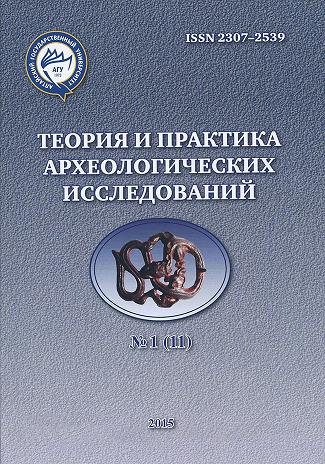UNIQUE FINDS OF THE EPOCH OF EARLY IRON FROM TATARSTAN
Abstract
In the article the unique finds of an epoch of the early Iron Age are considered. It is the bronze vesselmade on the Caucasus at the end of VIII – the beginning of VII century B.C. At this time it was deliveredto Middle Volga region. It is a unique find of the whole bronze vessel of an epoch of the early Iron Age interritory of Tatarstan. The small bronze figurine was made in the Caucasus. It represents a standing personin a high hairdress. It is dated by IV century BC – II century AD. It was found in Biljarsk which is located inAlekseevsky area of Tatarstan. It was stored by the Kazan collector A.F. Lihachev. Now the artefact is in theNational museum of the Tatarstan republic. A unique find is the iron Scythian sword (akinakes) second halfVII century BC, found out in a city of Chistopol in Tatarstan. It has been bent during some ritual. It is themost northern find of swords «tip Kelermes» in the Eastern Europe. The set from 16 bronze decorated platesof the trapezoid, rectangular and square form which have been found out on IV Murzihinsky burial groundof an epoch of the early Iron Age is interesting as well. They were connected with each other by thin leatherthongs. Plates were put in a small hole, near to ancient burial places. These plates are dated by VII centuryBC. They were possibly made in the Сaucasus.
Downloads
Metrics
No metrics found.
References
Брилева О.А. Древняя бронзовая антропоморфная пластика Кавказа (XV в. до н.э. - X в.н.э.). М.: Таус, 2012. 424 с.
Ворошилов А.Н. Случайные находки архаических акинаков как источник по истории лесостепного Подонья в раннескифскую эпоху // Случайные находки: хронология, атрибуция, историко-культурный контекст: материалы тематической научной конференции / Отв. ред. Д.Г. Савинов, 2008. С.91-96.
Денисов А.В. Случайные находки клинкового оружия раннего железного века с территории Самарского Поволжья // 40 лет Средневолжской археологической экспедиции: Краеведческие записки СОКМ. Вып.XV. Самара: ООО «Офорт», 2010. С.222-230.
Козенкова В.И. Оружие, воинское и конское снаряжение племен кобанской культуры (систематизация и хронология). Западный вариант: САИ. Вып.2-5. М.: ИА РАН, 1995. 166 с.
Козенкова В.И. Культурно-исторические процессы на Северном Кавказе в эпоху поздней бронзы и в раннем железном веке (Узловые проблемы происхождения и развития кобанской культуры). М.: ИА РАН, 1996. 164 с.
Коренюк С.Н. Ананьинская культура в трудах А.П. Смирнова и новые данные в ее изучении // Научное наследие А.П. Смирнова и современные проблемы археологии Волго-Камья. Материалы научной конференции: Труды ГИМ. Вып.122 / Отв. ред. И.В. Белоцерковская. - М.: ГИМ, 2000. С.68-79.
Марков В.Н. Исследования городища Черепашье // АО–1983. М. 1985. С. 162.
Патрушев В.С. Марийский край в VII - VI вв. до н.э. (Старший Ахмыловский могильник). - Йошкар-Ола: Марийское кн. изд-во, 1984. 230 с.
Патрушев В.С., Халиков А.Х. Волжские ананьинцы (Старший Ахмыловский могильник). - М.: Наука, 1982. 300 с.
Руденко К.А. Малополянское V селище // Культуры евразийских степей второй половины I тысячелетия н. э. (вопросы хронологии). Материалы II Международной археологической конференции 17-20 ноября 1997 г. Самара, 1998. С. 185-197.
Руденко К.А. Остров «Мурзиха» и его окрестности. Хронологический атлас археологических коллекций НМ РТ (1991-1999 гг.) Опыт микрорегионального исследования. Каталог археологических коллекций НМ РТ. Казань: РИЦ «Школа». 2002. 208 с.
Руденко К.А., Декоративно-прикладное искусство раннеананьинского времени (по материалам IV Мурзихинского могильника в Татарстане, предварительный анализ) // Культуры степной Евразии и их взаимодействие с древними цивилизациями. Книга 1. CПб: ИИМК РАН, «Периферия». 2012. С. 226-231.
Рябкова Т.В. Изделия с перегородчатой инкрустацией в предскифских и раннескифских памятниках // Труды IV (XX) Всероссийского археологического съезда в Казани. Том II. Казань: Отечество, 2014. С.163-168.
Топал Д. А., Бруяко И. В. Находки клинкового оружия ранних кочевников из Оргеевского района (Республика Молдова) // Stratum plus. 2012. №3. С.1-11.
Халиков А.Х. Волго-Камье в начале эпохи раннего железа (VIII – VI вв. до н.э.) М.: Наука. 1977. 264 с.
Хомчик М.О., Шовкопляс Г. М. Знахiдки ранньоï пори залiзного вiку з Киева (iз збiрок Державного iсторичного музею УРСР // Археологiя. 1984. №46. С.80-86.
Theory and Practice of Archaeological Research is a golden publisher, as we allow self-archiving, but most importantly we are fully transparent about your rights.
Authors may present and discuss their findings ahead of publication: at biological or scientific conferences, on preprint servers, in public databases, and in blogs, wikis, tweets, and other informal communication channels.
Theory and Practice of Archaeological Research allows authors to deposit manuscripts (currently under review or those for intended submission to ABS) in non-commercial, pre-print servers such as ArXiv.
Authors who publish with this journal agree to the following terms:
- Authors retain copyright and grant the journal right of first publication with the work simultaneously licensed under a Creative Commons Attribution License (CC BY 4.0) that allows others to share the work with an acknowledgement of the work's authorship and initial publication in this journal.
- Authors are able to enter into separate, additional contractual arrangements for the non-exclusive distribution of the journal's published version of the work (e.g., post it to an institutional repository or publish it in a book), with an acknowledgement of its initial publication in this journal.
- Authors are permitted and encouraged to post their work online (e.g., in institutional repositories or on their website) prior to and during the submission process, as it can lead to productive exchanges, as well as earlier and greater citation of published work (See The Effect of Open Access).








2.jpg)




